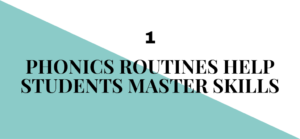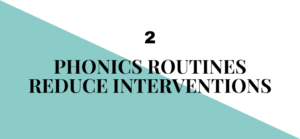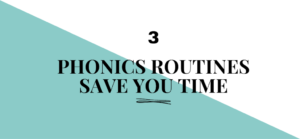Whether this is your 1st year of teaching, your 5th, or your 15th, if you don’t have set phonics routines in your reading instruction, then stop what you’re doing and implement them now!
The three biggest benefits to having set phonics routines are:
- They help students master phonics skills
- They cut down on the need for individualized interventions
- They save you time
So, what are phonics routines?
Phonics routines are simple procedures teachers implement that introduce sounds, blend words, and decode words. These procedures are explicitly taught to students. They are predictable. And while the words and sounds used each day change, the overall structure of how to introduce, decode, and blend those words stays the same.
Why implement them?
Let’s go back to those benefits and take a deeper dive into each one.
1 – Phonics routines help students master phonics skills
Since these routines are predictable and easy to follow, students know exactly what is expected of them. This cuts down on redirecting and distractions because students are able to focus on the task at hand, knowing exactly what is coming next. The routines also help you keep a brisk pace which students find more engaging and gives them less “down time” time to get off task.
More time on task and having clear expectations from routines also combines with an increase in opportunities for students to respond and continuous review that routines also provide. As students have more chances to respond and actively participate in their learning, students master the phonics concepts in shorter amounts of time.
Routines also offer easy opportunities to review past phonics skills which are repeatedly reinforced throughout the year. This creates deeper and longer lasting learning – true mastery of skills.
2 – Phonics routines cut down on the need for individualized intervention
With more chances to respond, more time on task, and more cyclical review, extra support is already “baked in” to the regular lesson plan. These routines can also be utilized to begin small group instruction, which again adds more opportunities to respond, practice, and review. By strengthening whole group and small group instruction with phonics routines, students begin to learn and master content quicker. This added layer of support cuts the need for interventions for most students.
Yes, some students may still need more than just whole group and small group instruction. That is the nature of education. However, your total number of students who need those interventions will be reduced. Plus, if a student isn’t making gains with the strengthened whole group and small group instruction, you as a teacher are in a much stronger position for advocating for that student to get extra help beyond what you can provide by yourself from other support structures in your school.
3 – Phonics routines save you time
Phonics routines aren’t just impactful for students’ learning. They are also impactful for you as a teacher and as a person. How many hours do you spend planning and prepping? It’s probably too many to count. And if I were a betting woman, I’d put money on the fact that you have to spend not just your work hours but also your personal time prepping for all you do in your classroom. Am I right?
The predictability and methodical process that routines bring help you reduce the hours you spend prepping. When you’ve got four or five effective phonics routines up your sleeve, all you need is a list of words that correspond to your phonics skill of the week plus a few review words from previous weeks and viola! You’re ready to go.
In some ways, phonics routines may sound too good to be true. But they aren’t.
They are simple, effective systems to explicitly teach kids the skills they need to learn. The added bonus is that you get some of your time back. Time you deserve. If you want to spend that time binge watching Netflix, hiking up a mountainside, skiing down a slope, or even planning and prepping a different lesson, go for it! 🙂 You do you.
Just know that you do not have to be working so hard on your phonics instruction. Work smarter, not harder. You can get better results and save yourself time by implementing clear phonics routines.










